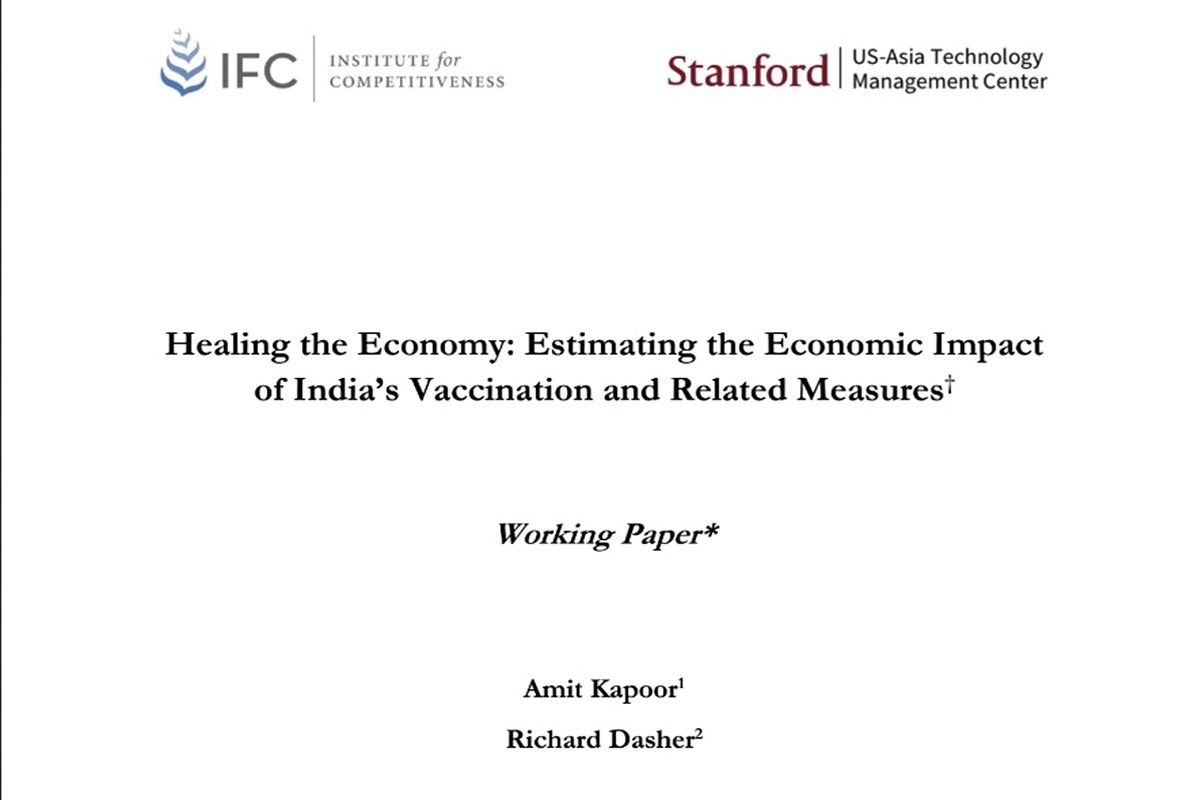

“Much before Covid-19 was declared a public health emergency by World Health Organization (WHO) in Jan 2020, processes and structures to focus dedicatedly on various facets of pandemic management were put in place. India under the leadership of Hon. Prime Minister Shri Narendra Modiji adopted a ‘Whole of Government’ & ‘Whole of Society’ approach in a proactive, preemptive & graded manner thus adopting a holistic response strategy, for effective management of Covid-19”. This was stated by Dr Mansukh Mandaviya, Union Minister for Health and Family Welfare as he virtually addressed the ‘The India Dialog’ session on the Economic Impact of Vaccination & Related Matters today. The dialog was organized by Institute for Competitiveness and US-Asia Technology Management Center, Stanford University.
He also released the working paper by Stanford University and Institute for Competitiveness titled “Healing the Economy: Estimating the Economic Impact on India’s vaccination and related issues”. The paper discusses the role of containment as a measure to prevent the spread of the virus. It highlights that, as against the top-down approach, a bottom-up approach was critical in containing the virus. Moreover, the Stanford report remarkably notes that robust measures at the ground level, like contact tracing, mass testing, home quarantine, distribution of essential medical equipment, revamping healthcare infrastructure, and constant coordination among stakeholders at the centre, state, and district levels, not only helped contain the spread of the virus but also in augmenting the health infrastructure.
It elaborates the three cornerstones of India’s strategy – containment, relief package, and vaccine administration. It observes that these three measures were critical in saving lives and ensuring economic activity by containing the spread of the COVID-19, sustaining livelihoods, and developing immunity against the virus. The working paper further notes that India was able to save more than 3.4 million lives by undertaking the nationwide vaccination campaign at an unprecedented scale. As per the working paper, the vaccination campaign was always on saving lives. However, it also yielded a positive economic impact by preventing the loss of US$ 18.3 billion. A net benefit of US$ 15.42 billion occurred for the nation after taking into consideration the cost of the vaccination campaign.
Praising the countrymen’s efforts, Dr. Mandaviya credited a large part of the success to the citizens who cooperated with the government and other stakeholders in the fight against COVID. Hailing the decision of early lockdown by the Prime Minister as a significant turning point, Dr. Mandaviya alluded that it enabled the government to leverage community response in its five-pronged strategy to combat COVID-19 namely Test- Track – Treat – Vaccination – Adherence for implementing Covid Appropriate Behaviour (CAB) and delivering a rapid and robust institutional response.
Reiterating the need for robust cooperation among stakeholders, Dr. Mandaviya said that “government focused on augmenting health infrastructure in terms of Covid related beds, drugs, logistics i.e., N-95, PPE kits and medical oxygen, simultaneously up-skilling human resources though Centres of Excellences and deploying digital solutions such as eSanjeevani Telemedicine service, Aarogya Setu, Covid-19 India Portal etc.” Equal weightage was given to scaling up the testing infrastructure at an unprecedented rate exceeding the superlative figure of 917.8 million tests conducted. Additionally, a network of52 labs for Genomic Surveillance were established for monitoring emerging variants of the virus, he further added.
Dr. Mandaviya stated that “building on this momentum, India launched the world’s biggest vaccination drive, garnering a coverage of 97% 1st dosage and 90% of the 2nd dosage, administering 2.2 billion dosages in all for eligible beneficiaries. The drive focused on equitable coverage for all, hence vaccines were provided free of cost to all citizens. Campaigns and digital tools such as ‘Har Ghar Dastak’, mobile vaccination teams as well as the inception of Co-Win vaccine management platform were leveraged to ensure last-mile delivery.” A defining factor in the success of pandemic management was allaying fears, managing misinformation and infodemic in the community through targeted Information, Education and Communication, he further added.
The report reflected that the benefits of vaccination exceeded its cost and suggested that vaccination be considered a macroeconomic stabilizing indicator contrary to just a health intervention. “The cumulative lifetime earnings of the lives saved through vaccination (in the working age group) rolled up to $ 21.5 billion”, highlighted the working paper. As per the Stanford University report, “the development of all these vaccines (COVAXIN & Covishield) helped fight the country’s pernicious attack of the virus and not only inoculate a large number of people but also decrease the burden on the healthcare system”.
Hailing the relief packages for citizens, Dr. Mandaviya stressed that “a constant coordination among stakeholders at the centre, state, and district levels, was observed which not only helped mitigating the adverse effects of COVID-19 but also provided an impetus to the economic activities.” The relief package by the government catered to the welfare needs of the vulnerable groups, old age population, farmers, Micro, Small & Medium Enterprises (MSMEs), women entrepreneurs amongst others and also ensuring support for their livelihoods. “With the help of schemes launched to support the MSME sector, 10.28 million MSMEs were provided assistance resulting in an economic impact of US$ 100.26 billion which comes out to be about 4.90% of the GDP”, he further added.
Ensuring food security during the pandemic, Dr. Mandaviya informed everyone about initiatives like Pradhan Mantri Garib Kalyan Ann Yojana (PMGKAY) which has also been highlighted in the Working Paper. According to the report, the Government focused on ensuring that no one slept hungry & free food grains were distributed to 800 million people which resulted in an economic impact of approximately US$ 26.24 billion. Additionally, the launch of PM Garib Kalyan Rozgar Abhiyan helped in providing immediate employment & livelihood opportunities to migrant workers. Through the scheme 4 million beneficiaries were provided employment which resulted in an overall economic impact of US$ 4.81 billion. This provided livelihood opportunities and created an economic buffer for citizens, the Working Paper points out.